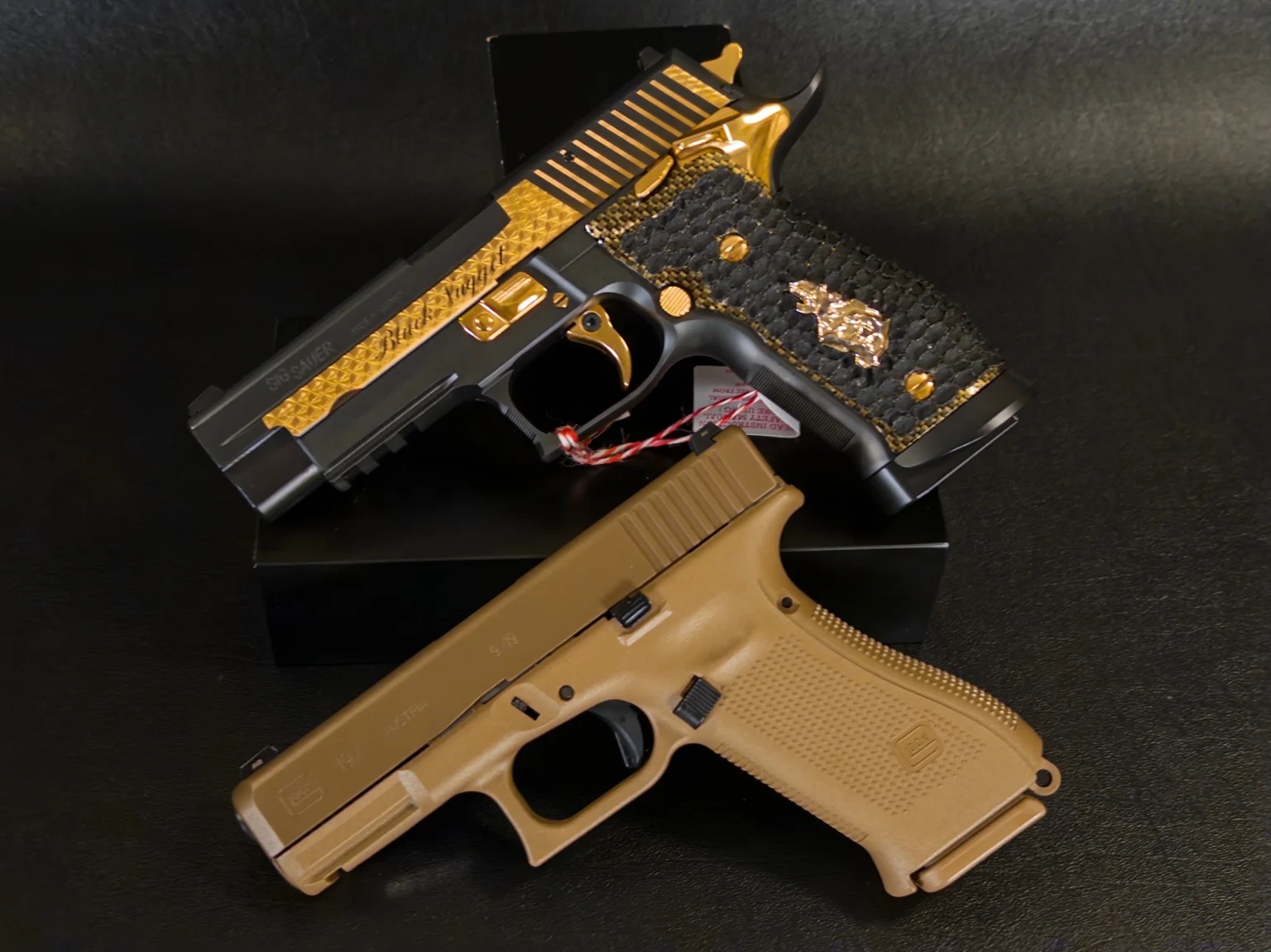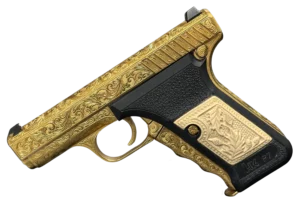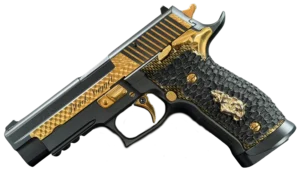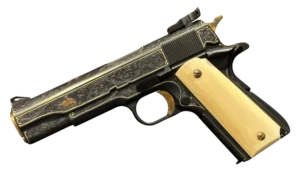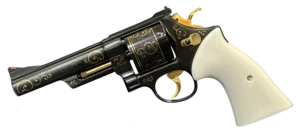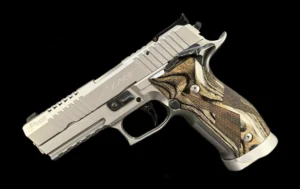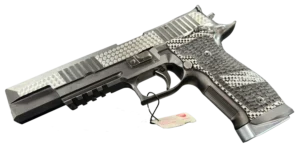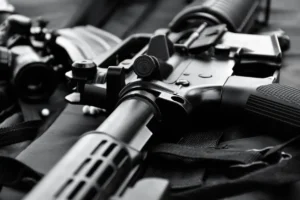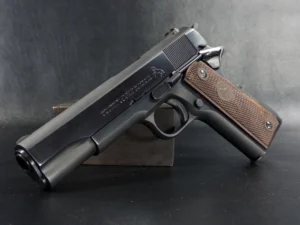Key Takeaways:
- Collectible firearms are all about the story, not just the steel: It’s not enough for a gun to be old or fancy. What makes it collectible is its connection to something bigger: a war, a moment, a person. Provenance, rarity, craftsmanship — those things matter, sure. But in the end, collectors are chasing stories they can hold in their hands.
- Non-collectible doesn’t mean worthless — it just means purposeful: Modern, mass-produced firearms get a bad rap in collector circles, but let’s be honest: they do the job. They’re reliable, accessible, and built for use, not display. And who knows — today’s carry gun might be tomorrow’s surprise auction gem. Stranger things have happened.
- The real joy of collecting isn’t owning — it’s connecting: This hobby isn’t just about stockpiling cool stuff. It’s about digging into history, learning from others, preserving craftsmanship, and maybe even passing something meaningful down. Whether you’re into antique flintlocks or Cold War sidearms, the heart of collecting is the same: curiosity, care, and a deep respect for where these things have been.
There’s something about a well-worn rifle with a story behind it that just hits differently. Maybe it saw action on a battlefield, or maybe it belonged to someone who mattered. You don’t get that with a fresh-off-the-line polymer pistol. Both have their place, but let’s talk about what actually separates collectible firearms from their more utilitarian cousins.
It’s not just about age or shine. It’s about story, scarcity, and soul.
So… What Makes a Gun “Collectible,” Anyway?
Let’s get this out of the way: not every old gun is collectible. And not every collectible is ancient. The whole thing’s more nuanced than just vintage vs. modern. You’re really looking at a handful of overlapping factors—historical significance, rarity, condition, provenance, and yeah, sometimes just plain good looks.
Take history, for example. A sidearm used in World War II? That’s a slice of time you can hold in your hands. The same goes for a revolver carried by a lawman in the Old West. These aren’t just guns—they’re relics. Anchors to a very real past.
And then there’s rarity. If only a few hundred of something were ever made—or if most didn’t survive intact—suddenly, everyone wants one. Human nature, right?
Condition matters too. A pristine finish, original parts, and smooth mechanics can make or break value, especially if you’re looking to invest. But here’s the kicker: sometimes a little honest wear tells its own story. That balance is where collectors get all misty-eyed.
And don’t sleep on provenance. A letter from the original owner, or documented ties to someone famous? That can bump a gun’s value into the stratosphere. It’s the difference between “a cool old rifle” and “the rifle that was carried through Bastogne.”
Craftsmanship ties it all together. Some firearms are flat-out gorgeous. Hand-engraved details. Rare wood grips. Gold inlays. You don’t even have to be a gun person to see the artistry in them.
Put it all together—history, rarity, condition, provenance, craftsmanship—and you’ve got something that’s not just a tool. It’s a conversation piece. Maybe even an heirloom.
And Then There’s the Other Kind…
Now let’s talk non-collectibles. And no shade here—they’re the backbone of modern firearm use.
These are your everyday workhorses. The polymer-frame pistols, AR-15s, and tactical shotguns. The stuff people actually carry, shoot, and train with. You’ll find them in duty holsters, safes, and glove boxes. They’re built for reliability, not rarity.
Most of them are mass-produced, which means they’re everywhere and not particularly special in a historical sense. They haven’t been to war. They weren’t carried by a famous general. They’re just solid tools for the job.
And that’s okay.
There’s a kind of beauty in functionality. A Glock 19 might not win any design awards, but it’ll go bang when you need it to. It’s not collectible. It’s dependable. And for a lot of people, that’s what matters.
But here’s the thing: non-collectibles today can sometimes become collectibles tomorrow. Especially limited editions, commemorative runs, or anything discontinued that folks didn’t think to stash away. That’s where it gets fun.
Collectible vs. Non-Collectible: The Real Differences
Let’s break this down a little more clearly. Side by side, here’s what you’re looking at:
Collectible Firearms:
- Tied to a moment in history or a notable person.
- Often rare or limited in production.
- Usually high craftsmanship, with attention to detail.
- Value tends to appreciate over time.
- People buy them to admire, preserve, maybe pass down.
Non-Collectible Firearms:
- Mass-produced and widely available.
- Designed primarily for performance and utility.
- Value is stable or decreases with use.
- No big historical backstory or artistic flourishes.
- Bought to be used, not displayed.
The key difference? Collectibles are conversation starters. Non-collectibles are problem solvers.
Why History (and Provenance) Matters So Much
If there’s one factor that really pushes a firearm into collectible territory, it’s history.
Think about a Civil War musket. It’s not just wood and iron—it’s a silent witness to a brutal and defining chapter in American history. The same goes for a pistol from WWII or a rifle used in Vietnam. They’re more than objects. They’re artifacts.
And provenance is like the DNA test of collectibles. Without it, you’re just taking someone’s word for it. With it? You’ve got a narrative backed by receipts—sometimes literally. Documentation, photos, letters, and military records. That’s the kind of stuff that makes collectors light up.
Funny enough, provenance doesn’t always have to be tied to war. A revolver that belonged to a Hollywood actor, a rifle gifted by a president—those stories have their own gravity.
Rarity, Condition, and the Weird Alchemy of Value
You’d think the rarest gun would always be the most valuable. But nope—it’s a little messier than that.
Sure, limited production runs are a good start. So are weird design features that didn’t stick around long. But if the thing’s beat to hell and missing half its parts, it might not be worth much. That’s where the condition comes in.
Original finishes, matching serial numbers, factory components—those are gold. Restoration is tricky. A perfectly refinished gun might look gorgeous, but to some collectors, that erases its soul. Others love a well-done refresh. It’s a delicate dance.
Then there’s market timing. A forgotten model can suddenly skyrocket in value thanks to a movie, a big auction sale, or even a random Reddit post. The collector world moves in waves.
So yeah—rarity matters. But so does timing. And taste. And sometimes dumb luck.
The Different “Flavors” of Collectibles: Antique, Vintage, Modern
Let’s not lump them all together. Collectible guns come in a few broad categories, and each one speaks to a different kind of collector.
Antique Firearms:
Technically, this means pre-1899. These can often be owned without modern licenses (depending on your laws). Think flintlocks, percussion revolvers, or early cartridge guns. They’re usually admired for their history more than their shooting ability.
Vintage Firearms:
A bit newer—maybe early 20th century through mid-century. These might’ve seen both World Wars or been popular hunting rifles in your grandfather’s time. They’re old, but not ancient. They’ve got stories and often shoot just fine.
Modern Classics:
These are the surprise entries. Maybe a 1980s SIG Sauer, a limited-edition Colt Python, or a factory race gun from the 2000s. Not old per se, but rare, desirable, and increasingly hard to find in good shape. The sleeper hits of the collector world.
Point is, “collectible” isn’t just about age. It’s about resonance. Some people drool over a Civil War musket. Others would give their left hand for a pristine HK P7M8.
Where the Magic Happens: Auctions, Dealers, and Finding “The One”
Let’s be real—collecting isn’t just about owning stuff. It’s about the hunt.
That’s where auctions and dealers come in. If you’re serious about finding great pieces (and not getting taken for a ride), these are your go-tos.
Rock Island Auction Company is the big dog. Their catalogs read like museums, and their hammer prices are often jaw-dropping. They’ve earned that rep—transparent listings, deep provenance research, and some of the rarest pieces on the market.
Luxus Capital leans into investment-grade pieces. If you’re more “private vault” than “display case,” this is where you go. They don’t just sell you a gun—they help you treat it like an asset.
Atlas Collectible Firearms specializes in vintage and antique firearms. Less glitz, more heart. Perfect for the history buff who’d rather own a battered trench pistol than a pristine display queen.
These folks don’t just sell guns. They set the tone for what the market values. They build community. And sometimes, they drop that one-in-a-million piece that’ll haunt you until you cave and bid.
Investing in Firearms: Smart Play or Nostalgic Gamble?
Some people approach collectible firearms like they’re buying stocks. And… that’s not totally wrong.
The market has been strong. Demand for historically significant, well-preserved pieces has climbed steadily. And since they’re physical assets, they can hedge against inflation in weird economic times.
But here’s the thing: not every collectible appreciates. Some fizzle. Others boom. The trick is doing your homework—and honestly, buying what you love. Passion tends to age better than hype.
Look for:
- Historical significance (duh)
- Strong provenance
- Limited production
- Original condition
Also, don’t ignore the legal stuff. Certain guns require extra paperwork. Some are banned in specific states or countries. If you’re not careful, you might end up owning something you can’t even legally keep.
Talk to experts. Ask dumb questions. Better that than dumb purchases.
How to Keep Them Alive: Preservation Tips That Actually Matter
Owning a collectible firearm is only half the job. Keeping it in good shape? That’s where the work begins.
Moisture is the enemy. Keep humidity in check. Use dehumidifiers or silica packs. Rust loves to sneak up on you.
Light is sneaky, too. Direct sunlight can fade finishes or warp wood over time. Display with care, or keep them in secure, dark storage.
Cleaning? Go easy. You’re not scrubbing a rental Glock. Use soft cloths, the right oil, and don’t get obsessive. Over-cleaning can do more harm than good.
And document everything. Condition photos, maintenance logs, and purchase receipts. If you ever want to sell (or just brag), this stuff matters.
One more thing—ensure your collection. Seriously. Fires, floods, break-ins… it happens.
The Legal + Ethical Minefield (Because Yep, That’s a Thing)
The legality of gun collecting isn’t just red tape—it can be the difference between “cool hobby” and “federal offense.”
Some states or countries regulate antique guns differently. Some require permits. Others are weird about importing certain pieces. Don’t assume. Know your laws.
Then there’s the ethical stuff. Not every historical gun has a clean past. Some are tied to colonial violence, genocide, or other dark chapters. If you’re gonna collect, it helps to also understand—and acknowledge—where your pieces came from.
Counterfeits are another danger. If it sounds too good to be true, it probably is. Do the research. Ask for provenance. Get second opinions.
Bottom line: be a good steward of history. That’s really what collecting is about.
Starting a Collection: Tips From the Trenches
Thinking about starting a collection? Cool. Here’s how to not screw it up.
- Start with what interests you. Not what’s trendy. Not what your buddy collects. If you’re into Cold War pistols, go there. If cowboy guns are your thing? Giddy up.
- Learn. Constantly. Read books. Join forums. Go to shows. Ask dumb questions. Everyone starts somewhere.
- Don’t blow your whole budget on your first piece. Tempting, I know. But give yourself space to learn. Your taste will evolve.
- Buy when you can. Better to have one stunning example than three beaters you regret.
- Keep your documentation. Trust me—you’ll thank yourself later.
And remember—this isn’t just a hobby. It’s a slow, joyful dive into craftsmanship, history, and sometimes obsession. There’s no finish line. Just a lot of really interesting stops along the way.
Final Thought: Why We Collect
It’s not about owning a pile of old guns.
It’s about the stories they tell. The way they connect us to people, places, and times we’ll never know firsthand. It’s about holding something real—something that’s been somewhere, meant something, done something.
Collecting firearms isn’t just nostalgia. It’s a form of preservation. Of history, of beauty, of function, and form.
So yeah, maybe your polymer pistol will never make it to auction.
But that Luger your grandfather smuggled home from Europe? That’s something else entirely.
And that’s the magic.
Frequently Asked Questions
Not at all. Age helps, sure—but it’s not the whole story. A modern firearm can still be collectible if it was made in small numbers, has ties to a historically significant event, or simply strikes a sweet spot with enthusiasts. Some 1980s pistols are already climbing in value. Weird, right?
Honestly? It comes down to intention and story. Collectibles are valued for their history, rarity, and aesthetics. Non-collectibles? They’re built to be used, not admired. It’s about legacy. The other’s about utility. Both serve a purpose, just in very different ways.
Good question. Just because something’s old doesn’t make it valuable. Look for items with documented history (provenance), original condition, limited production numbers, and connections to significant events or figures. If it checks a few of those boxes, you might be onto something.
Yep, it happens more than you’d think. Limited-run modern pistols, military-issue gear, or discontinued models can become highly sought after decades after their initial release. It’s a bit like comic books—sometimes you don’t know you had gold until the market catches up.
It can be… if you know what you’re doing and you’re in it for the long haul. The best returns usually come from guns with strong provenance, excellent condition, and high rarity. But let’s be real—it’s a passion game first, and a money game second. Buy what you love, not just what you think might flip well.


